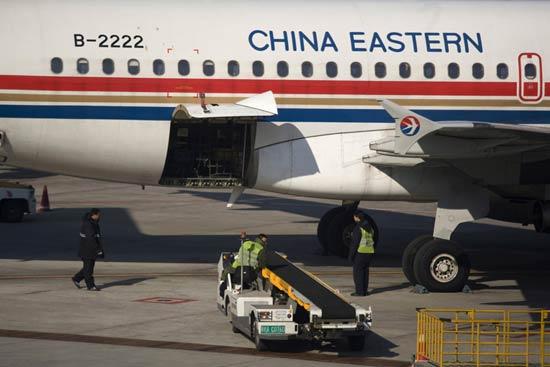
Airport personnel load a China Eastern Airlines Co Ltd passenger airplane at Beijing International Airport. [Photo / Agencies]
Radical reforms at China Eastern help it to turn around its business
SHANGHAI - When he entered the room, Liu Shaoyong, general manager of China Eastern Airlines Group and chairman of China Eastern Airlines Co Ltd, was 10 minutes earlier than he was expected.
"All of our time pieces, whether worn on the wrist or kept in the office, are set 10 minutes in advance," he said. "We dare not be behind. What decides our fate is the attitude toward difficulties."
In China Eastern, everyone is required not to waste time and make preparations in advance. It is partly because of this state of attentiveness and vigilance that the airline has moved from being near the edge of bankruptcy to becoming a high earner.
Explosive growth
In 2010, China Eastern Airlines Co Ltd realized a total profit of 5.84 billion yuan ($898 million), a record since its establishment. The company paid taxes of nearly 4 billion yuan, revealing explosive growth in the carrier's profitability.
However, two-and-a-half years ago, China Eastern was in the red. In 2008, it lost 13.8 billion yuan, and its debt-to-asset ratio was as high as 115 percent.
In Liu's words, what brought the airline back to life was the outcome of three battles - the need to survive, the need to restructure and the World Expo Shanghai 2010.
The consequent success story enabled the company to grow even after the expo ended.
Liu said the rising demand of air transportation in the country will continue to benefit the airline's robust growth this year, despite the increase in the cost of fuel and domestic competition from high-speed railways.
He added the company's transportation capacity will increase 8 to 10 percent in the form of a new fleet of 25 aircraft this year to meet the expected growth of 20 percent in the country's air passenger volume.
Next month, China Eastern will officially join the global SkyTeam Alliance in order to be further integrated into the global market and expand its international presence.
With renewed and added destinations including London, New York and Rome to lure more international and domestic travelers, the carrier is expected to enhance its routes connecting major cities between North America and Shanghai.
In the domestic market, the airline is looking to build Shanghai as its regional hub for passengers in Eastern coastal provinces. Efforts such as setting up marketing centers in East China to further consolidate resources and markets in neighboring key areas including Zhejiang, Jiangsu and Anhui provinces, will be on the agenda to compete with high-speed railways. The high-speed railway networks are believed to have a bigger effect on routes that are less than 800 kilometers.
Looking back, as "a phoenix is reborn from fire", said Liu, who landed his current position at the end of 2008, the fast strengthening of today's China Eastern business, brand image and competitiveness drives the Shanghai-based carrier forward.
At the end of 2008, China Eastern Airlines, suffered from the international financial crisis. Thanks to strong support from central government, the new leadership of China Eastern was able to undertake 256 measures in a radical reform.
Ranking first

Take check-in service as an example. The 10 minutes of pre-service inspection and preparation enable staff to possess more accurate flight information in order to better improve the service of seat reservation, meal checking and passenger requirements. Waiting time has been shortened and communications have been improved. Feedback from passengers has been acted upon.
As a consquence, passengers are experiencing a change for the positive in the company. China Eastern Airlines topped the flight punctuality rankings of 2010 with 79.04 percent, more than 3 percentage points higher than the industry average, according to the Civil Aviation Administration of China. It was the third year in a row that China Eastern ranked first for punctuality.
China Eastern used to have an unsatisfactory network structure and lack of transfer abilities. With 3,000 new flights, the situation has been improved.
The restructuring of Eastern Airlines and Shanghai Airlines in 2009 eliminated unnecessary competition within one city and generated efficient integration. The merger between the two reduced operating costs and enhanced profitability. Through the integration of resources, 315 million yuan in costs were saved and 680 million yuan in redundant investment was cut.
Currently, China Eastern flies to 105 domestic cities and 47 overseas destinations.
China Eastern has suffered from rising oil prices. Ma Xulun, general manager of the company, works on the principle of profits from tiny margins. That means attention to detail, optimizing flight routes, adjusting the fleet structure and reducing fuel consumption. Nine McDonnell Douglas MD-90 aircraft were replaced with new energy-saving models.
China Eastern Airlines has increased or restored several international routes and improved services to attract more international clients. Employees are encouraged to work to the motto: "We strive to do what passengers expect. We fight for unexpected goals. We will send you to wherever you want".
As a State-owned enterprise, China Eastern says it seeks to look after staff, customers, shareholders and the wider community equally.





